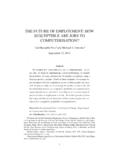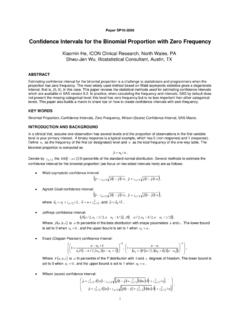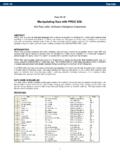Transcription of 226-2008: Old Versus New: A Comparison of PROC …
1 1 Paper 226-2008 Old Versus New: A Comparison of PROC LOGISTIC and PROC GLIMMIX Rebecca Christofferson Department of Pathobiological Sciences LSU School of Veterinary Medicine, Baton Rouge, LA ABSTRACT In the past, the SAS programming tools available for logistic regression problems have been trapped in a fixed effects modeling world. PROC LOGISTIC gives very few options when dealing with random effects, which has made the modeling of binary data from any kind of experimental design challenging at best. Such design elements as blocking or repeated measures are not readily analyzed using PROC LOGISTIC.
2 PROC GLIMMIX has sought to fill in the gaps. With this new procedure, design elements can be accounted for and a more correct modeling of variances can be done. The popular and useful mixed modeling techniques available in PROC MIXED can now be readily utilized for the analysis of binary data using PROC GLIMMIX. A practical example will demonstrate the convenience features GLIMMIX offers, and also highlight the differences between the two procedures, using a side-by-side Comparison . Data from an experiment involving sperm morphology in game deer will be utilized for this simple demonstration.
3 INTRODUCTION Control of variation is commonly the goal of statistical modeling. In the past, logistic regression using the statistical procedures available in SAS has limited statisticians and programmers to corralling logistic and binary problems into fixed effects models. However, modeling of random effects is important for accuracy. In the past, there was no easy way to control for variation caused by such things as experimental design or blocking effects. Recently, however, a new procedure has changed the way SAS/STAT users program for logistic regression. This paper seeks to contrast the old way (PROC LOGISTIC) with a new procedure (PROC GLIMMIX) to illustrate the differences and improvements afforded by GLIMMIX, but by no means is intended to be a comprehensive report on either procedure.
4 Rather, this is an introduction to the exciting potential of PROC GLIMMIX and a personal show of enthusiasm for the new procedure. What is the big deal with random effects? I ve been asked this question in consulting settings, so here goes an explanation. Picture yourself sitting in a quaint, crowded sidewalk caf in the dream destination city of your choice. Across from you is your vacation partner and the two of you are locked in a potentially riveting conversation (likely about SAS programming). The only problem is that you can t quite understand what your partner is saying because there is so much crowd noise.
5 There may be multiple sources of noise, such as the other people talking, maybe a construction site not very far away, and traffic. These other sources of noise are random effects; the conversation with your partner is the model you re interested in. In accounting for random effects, you filter out that crowd noise so that all you are left with is the clearest possible model (conversation). Your ears are suddenly very discerning and you are able to easily tell the difference between what is random noise and what is conversation. Binary data is often analyzed using logistic regression.
6 This paper will assume that the reader has at least a basic understanding of logistic regression. By using a simple example, this paper will highlight some of the new features PROC GLIMMIX offers for modeling of binary data in Comparison to those options currently available in PROC LOGISTIC. DATA & METHODOLOGY PROC LOGISTIC is a suitable procedure to utilize when true regression models are warranted, there are no random effects and your model is simple. However, in most research settings, experimental design is not only utilized, but it is a standard procedure. For this reason, modeling of binary data without accounting for the variation random effects may contribute has profound implications for the precision of models and predictions.
7 The Experiment The data is from an experiment that sought to determine the best treatment methods for the preservation of deer sperm function via cryogenesis. The treatment in this experiment was a four level treatment; levels were pre-freeze A & B Versus post-thaw A & B where A represents room temperature processing and B represents processing at a cooler temperature. They were coded as PFA, PFB, PTA, PTB and so were not done in a factorial design. Specifically, tail and head morphology was observed to determine sperm viability and thus, degree of preservation. PostersSASG lobalForum2008 2 Several morphological features of damaged sperm were measured.
8 If a sperm had no defects, it was assigned a "1," and if the sperm was deemed damaged, it was assigned a "0." All counts became a ratio of "success" (no damage, variable name: normal_ ) over total. In this experiment, sperm was collected from 7 deer which were treated as a random block effect. The model was established as: Yij = + i + j + ij Where is the overall mean, i is the fixed effect of trt at the ith level, j is the random effect of the jth deer, and is the residual error. Using PROC LOGISTIC, the basic SAS code could look as follows: proc logistic data=data; class trt; model normal_/total = trt; output out=pred_log; run; As is evident, there is no place in this procedure for easy address of the random effect of deer; there is no random statement available.
9 That means that the variation for that effect is essentially unaccounted for and the model is perhaps not as precise as it could be. All that variation is pooled into the residual error, making the test for the differences between the treatment groups not as precise. PROC GLIMMIX offers researchers the option of implementing a linear mixed model by including deer as a random effect. proc glimmix data=morph12o; class trt; model normal_/total = trt / dist=bin solution; output out=morphpred pred(ilink noblup)=pred resid=r ucl(ilink noblup)= up lcl (ilink noblup)=low; lsmeans trt /adjust=tukey; random deer / solution; run; Our model is now fully specified in the SAS coding.
10 The solution option in the random statement of PROC GLIMMIX offers us a test for significance for the random effect of deer. The output of that test is show below in table 1. Solution for Random Effects Effect EstimateStd Err PredDFt ValuePr > |t|Deer <.0001 Table 1 As you can see, the random effect of deer is significant. Again, by accounting for the variance, our ability to correctly detect differences based on this model is more precise. The Output The output for these two procedures looks different. However, it is important to note that the effect of trt is still analyzed by a difference in log-odds ratios, like PROC LOGISTIC.















